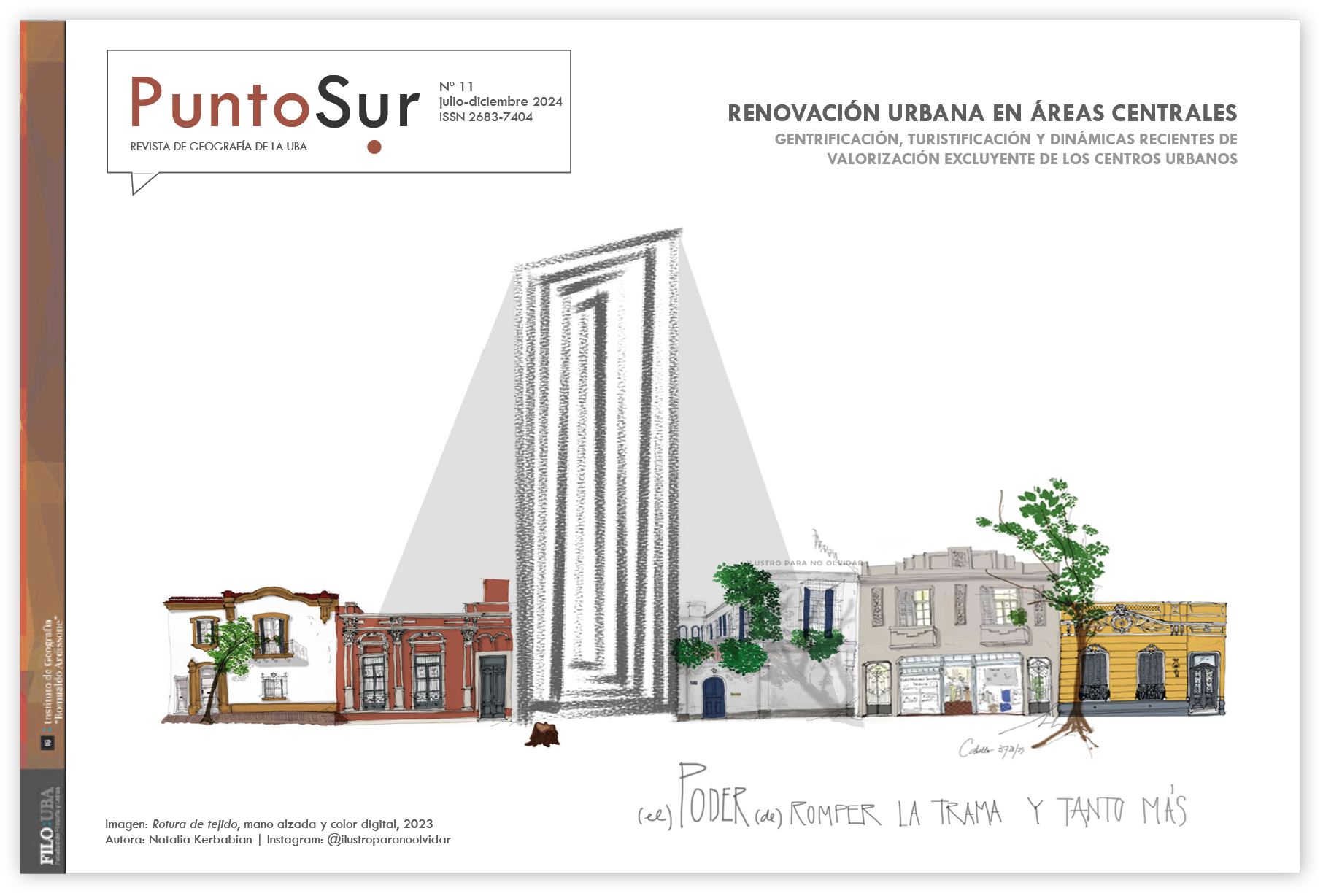Infraestruturas e Paradigmas Tecnoeconômicos na Região Pampeana da Argentina
Um estudo da seletividade estatal e da estruturação socioespacial
Resumo
O palimpsesto de infraestruturas que caracteriza os territórios contemporâneos reflete os ciclos históricos de valorização do capital através do investimento em novas tecnologias. No entanto, trata-se de uma paisagem opaca. Ainda desconhecemos os padrões de difusão dessas tecnologias e, mais ainda, seu caráter desigual e incompleto. Por meio de uma pesquisa exploratória, este artigo caracteriza as diferentes camadas geológicas das infraestruturas que configuram a região pampeana argentina, com o objetivo de evidenciar o processo de seletividade que o Estado e o capital global aplicam frente às crises de acumulação e à emergência de cada paradigma tecnoeconômico.Downloads
Não há dados estatísticos.
Referências
Appel, H., Anand, N., & Gupta, A. (2013). Temporality, politics, and the promise of infrastructure. Durham, NC: Duke University Press. https://doi.org/10.1215/9780822378563
Baladrón, M. (2019). El Plan "Argentina Conectada": Una política de Estado desde la infraestructura de comunicaciones. Ciencia, Tecnología y Política, 2(2), 017-017. https://doi.org/10.24215/26182859e017
Batty, M. (2013). The new science of cities. Cambridge, MA: The MIT Press. https://mitpress.mit.edu/9780262019521/the-new-science-of-cities/
Brenner, N. (2003). Glocalization as a state spatial strategy: Urban entrepreneurialism and the new politics of uneven development in Western Europe. In J. Peck & H. Wai-chung Yeung (Eds.), Remaking the global economy: Economic-geographical perspectives (pp. 197–215). London, Thousand Oaks, CA: SAGE. https://doi.org/10.4135/9781446216437.n12
Corboz, A. (1983). Le territoire comme palimpseste. Diogène, 121, 14–35. https://doi.org/10.3917/dio.121.0014
Cox, K. (1990). Territorial structures of the state: Some conceptual issues. Tijdschrift Voor Economische en Sociale Geografie, 81(4), 251–266. https://doi.org/10.1111/j.1467-9663.1990.tb01617.x
Chesnais, F. (2003). La teoría del régimen de acumulación financiarizado: Contenido, alcance e interrogantes. Revista de Economía Crítica, 1, 37-72. http://revistaeconomiacritica.org/sites/default/files/revistas/n1/02_Chesnais.pdf
Dematteis, G. (1995). Progetto implicito: Il contributo della geografia umana alle scienze del territorio. Milano: Franco Angeli. https://www.francoangeli.it/Ricerca/scheda_libro.aspx?ID=567
Dosi, G. (1982). Technological paradigms and technological trajectories: A suggested interpretation of determinants and directions of technical change. Research Policy, 11(3), 147-162. https://doi.org/10.1016/0048-7333(82)90016-6
Dupuy, G. (1998). El urbanismo de las redes: Teorías y métodos. Barcelona: Colegio de Ingenieros de Caminos, Canales y Puertos. https://www.ciccp.es/servicios/publicaciones/el-urbanismo-de-las-redes
Easterling, K. (2014). Extrastatecraft: The power of infrastructure space. London: Verso Books. https://www.versobooks.com/books/1892-extrastatecraft
Edwards, P. N. (2003). Infrastructure and modernity: Force, time, and social organization in the history of sociotechnical systems. In T. J. Misa, P. Brey, & A. Feenberg (Eds.), Modernity and technology (pp. 185–226). Cambridge, MA: MIT Press. https://mitpress.mit.edu/9780262633390/modernity-and-technology/
Elinbaum, P. (2023). Representaciones escalares de las infraestructuras portuarias: Urbanización, innovación tecnológica y división internacional del trabajo. 2º Jornadas CEUR: Espacio, tecnología y acumulación: los senderos del desarrollo y sus límites, 26-28 de julio de 2023, Buenos Aires, Argentina. http://ceur-conicet.gov.ar/jornadas-2023/
Erol-Kantarci, M., & Mouftah, H. T. (2011). Wireless sensor networks for cost-efficient residential energy management in the smart grid. IEEE Transactions on Smart Grid, 2(2), 314-325. https://doi.org/10.1109/TSG.2011.2114678
Etingoff, K. (Ed.). (2015). Urban ecology: Strategies for green infrastructure and land use. Boca Raton, FL: Apple Academic Press. https://www.routledge.com/Urban-Ecology-Strategies-for-Green-Infrastructure-and-Land-Use/Etingoff/p/book/9781771882825
Freeman, C., & Pérez, C. (1988). Structural crises of adjustment: Business cycles and investment behaviour. In G. Dosi, C. Freeman, R. Nelson, G. Silverberg, & L. Soete (Eds.), Technical change and economic theory (pp. 38-66). London: Pinter Publishers. https://www.routledge.com/Technical-Change-and-Economic-Theory/Dosi-Freeman-Nelson-Silverberg-Soete/p/book/9780861879282
Gandelsonas, M. (1998). The city as the object of architecture. Assemblage, 37, 128–144. https://www.jstor.org/stable/3171344
García, D. (1976). El desarrollo portuario argentino (Tesis doctoral, Universidad de Buenos Aires, Facultad de Ciencias Económicas). https://repositorio.uba.ar/handle/123456789/1928
Graham, S., & Marvin, S. (2001). Splintering urbanism: Networked infrastructures, technological mobilities and the urban condition. New York, NY: Routledge. https://doi.org/10.4324/9780203452202
Harvey, D. (1990). Los límites del capitalismo y la teoría marxista. Ciudad de México: Fondo de Cultura Económica. https://libreria.fondodeculturaeconomica.com.mx/products/los-limites-del-capitalismo-y-la-teoria-marxista
Herce, M. (2013). El negocio del territorio: Evolución y perspectivas de la ciudad moderna. Madrid: Alianza. https://alianzaeditorial.es/libro/alianza-ensayo/el-negocio-del-territorio-manel-herce-9788420672106/
Jessop, B. (1990). State theory: Putting the capitalist state in its place. University Park, PA: Pennsylvania State University Press. https://www.psupress.org/books/titles/0-271-00783-4.html
Jessop, B., Brenner, N., & Jones, M. (2008). Theorizing sociospatial relations. Environment and Planning D: Society and Space, 26(3), 389–401. https://doi.org/10.1068/d9107
Mandel, E. (1980). Long waves of capitalist development: A Marxist interpretation. Cambridge: Cambridge University Press. https://doi.org/10.1017/CBO9781139171280
Massey, D. (1985). New directions in space. In D. Gregory & J. Urry (Eds.), Social relations and spatial structures (pp. 9–19). London: Macmillan Education UK. https://link.springer.com/chapter/10.1007/978-1-349-27935-6_2
Massey, D. (1995). Spatial divisions of labour: Social structures and the geography of production. London: Palgrave. https://doi.org/10.1007/978-1-349-24186-5
Ngai, P., & Peier, C. (2022). Confronting global infrastructural capitalism: The triple logic of the 'vanguard' and its inevitable spatial and class contradictions in China's high-speed rail program. Cultural Studies, 37(6), 872-893. https://doi.org/10.1080/09502386.2022.2109457
Paterson, M. (2000). Car culture and global environmental politics. Review of International Studies, 26(2), 253-270. https://doi.org/10.1017/S0260210500002538
Perez, C. (1985). Microelectronics, long waves and world structural change: New perspectives for developing countries. World Development, 13(3), 441-463. https://doi.org/10.1016/0305-750X(85)90141-2
Perez, C. (2010). Technological revolutions and techno-economic paradigms. Cambridge Journal of Economics, 34(1), 185-202. https://doi.org/10.1093/cje/bep051
Rieznik, M. (2013). Dibujando con alambres la espaciotemporalidad en la Argentina del siglo XIX: Los esquemas de tendidos telegráficos diagramados por Manuel Bahía (1891). In A. Catálogo (Ed.), Geografía y cultura visual: Los usos de las imágenes en las reflexiones sobre el espacio (pp. 351-367). Rosario: Prohistoria. http://www.prohistoria.com.ar/libros/detalleLibro.php?bookId=142
Secchi, B. (1992). Urbanistica descrittiva. Casabella, 588, 22–23. https://www.casabellaweb.eu/1992/07/21/casabella-588/
Wellman, K., & Spiller, M. (2012). Urban infrastructure: Finance and management. Hoboken, NJ: Wiley. https://www.wiley.com/en-us/Urban+Infrastructure%3A+Finance+and+Management-p-9781118174237
Baladrón, M. (2019). El Plan "Argentina Conectada": Una política de Estado desde la infraestructura de comunicaciones. Ciencia, Tecnología y Política, 2(2), 017-017. https://doi.org/10.24215/26182859e017
Batty, M. (2013). The new science of cities. Cambridge, MA: The MIT Press. https://mitpress.mit.edu/9780262019521/the-new-science-of-cities/
Brenner, N. (2003). Glocalization as a state spatial strategy: Urban entrepreneurialism and the new politics of uneven development in Western Europe. In J. Peck & H. Wai-chung Yeung (Eds.), Remaking the global economy: Economic-geographical perspectives (pp. 197–215). London, Thousand Oaks, CA: SAGE. https://doi.org/10.4135/9781446216437.n12
Corboz, A. (1983). Le territoire comme palimpseste. Diogène, 121, 14–35. https://doi.org/10.3917/dio.121.0014
Cox, K. (1990). Territorial structures of the state: Some conceptual issues. Tijdschrift Voor Economische en Sociale Geografie, 81(4), 251–266. https://doi.org/10.1111/j.1467-9663.1990.tb01617.x
Chesnais, F. (2003). La teoría del régimen de acumulación financiarizado: Contenido, alcance e interrogantes. Revista de Economía Crítica, 1, 37-72. http://revistaeconomiacritica.org/sites/default/files/revistas/n1/02_Chesnais.pdf
Dematteis, G. (1995). Progetto implicito: Il contributo della geografia umana alle scienze del territorio. Milano: Franco Angeli. https://www.francoangeli.it/Ricerca/scheda_libro.aspx?ID=567
Dosi, G. (1982). Technological paradigms and technological trajectories: A suggested interpretation of determinants and directions of technical change. Research Policy, 11(3), 147-162. https://doi.org/10.1016/0048-7333(82)90016-6
Dupuy, G. (1998). El urbanismo de las redes: Teorías y métodos. Barcelona: Colegio de Ingenieros de Caminos, Canales y Puertos. https://www.ciccp.es/servicios/publicaciones/el-urbanismo-de-las-redes
Easterling, K. (2014). Extrastatecraft: The power of infrastructure space. London: Verso Books. https://www.versobooks.com/books/1892-extrastatecraft
Edwards, P. N. (2003). Infrastructure and modernity: Force, time, and social organization in the history of sociotechnical systems. In T. J. Misa, P. Brey, & A. Feenberg (Eds.), Modernity and technology (pp. 185–226). Cambridge, MA: MIT Press. https://mitpress.mit.edu/9780262633390/modernity-and-technology/
Elinbaum, P. (2023). Representaciones escalares de las infraestructuras portuarias: Urbanización, innovación tecnológica y división internacional del trabajo. 2º Jornadas CEUR: Espacio, tecnología y acumulación: los senderos del desarrollo y sus límites, 26-28 de julio de 2023, Buenos Aires, Argentina. http://ceur-conicet.gov.ar/jornadas-2023/
Erol-Kantarci, M., & Mouftah, H. T. (2011). Wireless sensor networks for cost-efficient residential energy management in the smart grid. IEEE Transactions on Smart Grid, 2(2), 314-325. https://doi.org/10.1109/TSG.2011.2114678
Etingoff, K. (Ed.). (2015). Urban ecology: Strategies for green infrastructure and land use. Boca Raton, FL: Apple Academic Press. https://www.routledge.com/Urban-Ecology-Strategies-for-Green-Infrastructure-and-Land-Use/Etingoff/p/book/9781771882825
Freeman, C., & Pérez, C. (1988). Structural crises of adjustment: Business cycles and investment behaviour. In G. Dosi, C. Freeman, R. Nelson, G. Silverberg, & L. Soete (Eds.), Technical change and economic theory (pp. 38-66). London: Pinter Publishers. https://www.routledge.com/Technical-Change-and-Economic-Theory/Dosi-Freeman-Nelson-Silverberg-Soete/p/book/9780861879282
Gandelsonas, M. (1998). The city as the object of architecture. Assemblage, 37, 128–144. https://www.jstor.org/stable/3171344
García, D. (1976). El desarrollo portuario argentino (Tesis doctoral, Universidad de Buenos Aires, Facultad de Ciencias Económicas). https://repositorio.uba.ar/handle/123456789/1928
Graham, S., & Marvin, S. (2001). Splintering urbanism: Networked infrastructures, technological mobilities and the urban condition. New York, NY: Routledge. https://doi.org/10.4324/9780203452202
Harvey, D. (1990). Los límites del capitalismo y la teoría marxista. Ciudad de México: Fondo de Cultura Económica. https://libreria.fondodeculturaeconomica.com.mx/products/los-limites-del-capitalismo-y-la-teoria-marxista
Herce, M. (2013). El negocio del territorio: Evolución y perspectivas de la ciudad moderna. Madrid: Alianza. https://alianzaeditorial.es/libro/alianza-ensayo/el-negocio-del-territorio-manel-herce-9788420672106/
Jessop, B. (1990). State theory: Putting the capitalist state in its place. University Park, PA: Pennsylvania State University Press. https://www.psupress.org/books/titles/0-271-00783-4.html
Jessop, B., Brenner, N., & Jones, M. (2008). Theorizing sociospatial relations. Environment and Planning D: Society and Space, 26(3), 389–401. https://doi.org/10.1068/d9107
Mandel, E. (1980). Long waves of capitalist development: A Marxist interpretation. Cambridge: Cambridge University Press. https://doi.org/10.1017/CBO9781139171280
Massey, D. (1985). New directions in space. In D. Gregory & J. Urry (Eds.), Social relations and spatial structures (pp. 9–19). London: Macmillan Education UK. https://link.springer.com/chapter/10.1007/978-1-349-27935-6_2
Massey, D. (1995). Spatial divisions of labour: Social structures and the geography of production. London: Palgrave. https://doi.org/10.1007/978-1-349-24186-5
Ngai, P., & Peier, C. (2022). Confronting global infrastructural capitalism: The triple logic of the 'vanguard' and its inevitable spatial and class contradictions in China's high-speed rail program. Cultural Studies, 37(6), 872-893. https://doi.org/10.1080/09502386.2022.2109457
Paterson, M. (2000). Car culture and global environmental politics. Review of International Studies, 26(2), 253-270. https://doi.org/10.1017/S0260210500002538
Perez, C. (1985). Microelectronics, long waves and world structural change: New perspectives for developing countries. World Development, 13(3), 441-463. https://doi.org/10.1016/0305-750X(85)90141-2
Perez, C. (2010). Technological revolutions and techno-economic paradigms. Cambridge Journal of Economics, 34(1), 185-202. https://doi.org/10.1093/cje/bep051
Rieznik, M. (2013). Dibujando con alambres la espaciotemporalidad en la Argentina del siglo XIX: Los esquemas de tendidos telegráficos diagramados por Manuel Bahía (1891). In A. Catálogo (Ed.), Geografía y cultura visual: Los usos de las imágenes en las reflexiones sobre el espacio (pp. 351-367). Rosario: Prohistoria. http://www.prohistoria.com.ar/libros/detalleLibro.php?bookId=142
Secchi, B. (1992). Urbanistica descrittiva. Casabella, 588, 22–23. https://www.casabellaweb.eu/1992/07/21/casabella-588/
Wellman, K., & Spiller, M. (2012). Urban infrastructure: Finance and management. Hoboken, NJ: Wiley. https://www.wiley.com/en-us/Urban+Infrastructure%3A+Finance+and+Management-p-9781118174237
Publicado
2024-11-14
Como Citar
Elinbaum, P., Vidosa, R., Lavarello, P., Guido , L., Bil, D., & Barchi, M. (2024). Infraestruturas e Paradigmas Tecnoeconômicos na Região Pampeana da Argentina. Punto Sur, (11), 157-179. https://doi.org/10.34096/ps.n11.14805
Seção
Artículos libres
Copyright (c) 2024 Pablo Elinbaum, Regina Vidosa, Pablo Lavarello, Luciana Guido , Damián Bil, Milagros Barchi

This work is licensed under a Creative Commons Attribution 4.0 International License.






















